The team is paramount
By Al R. Young
 |
| Tåkesangen (Song of the Mist) by Al R. Young |
dimensions (unframed width x height)
30 3/8 in. x 42 3/8 in. — lefthand panel
8 ft. x 4 ft. — center panel
30 3/8 in. x 42 3/8 in. — righthand panel
support
Panel
milestones
Painting completed — 2020 August
Based on regular entries in the project journal for this painting, creation of the artworks involved approximately 83 sessions (from composition and panel preparation to completion of brushwork).
equipment created or modified for this project
Owing to toxic and allergenic materials involved in creating this painting, it was necessary to create an outdoor studio. An already roofed and partially walled enclosure was selected and the following equipment and built-in features were added to the space:
Bug (glazing) tent
Overhead lighting
Painter's taboret (made from a moving dolly)
4x4-post easel
Installation of iron garden shelves for equipment storage
Installing a flat screen television
Creating a large, drafting-table-style easel
costumes, miniatures, and props created for this project
None.
methodology
This section presents only one or two items that may be of interest to professional artists, amateurs, and others interested in the work of the Studios.
Every project undertaken by an artist or a studio, shapes the artist, the artist's work, and the studio.
This particular commission was several years in coming (i.e., a proposal was submitted long before construction was tentatively scheduled to begin). After the proposal, a significant period of waiting ensued. When a decision was finally made, the project was instantly coupled with the horsepower of business management's focus on profit and loss, which was--as is always the case—quite short on time. I have never known such a coupling to be otherwise. A business that is not tight on time, even in funding its research and development efforts, probably isn't really a business. Additionally, by the time design proposals for this project were reviewed and accepted, much of the substance of the Studios' original proposal had changed materially. For example, the triptych was not originally to have been a triptych, but a single, large oil painting already selected from the Studios' portfolio of completed, original artworks.
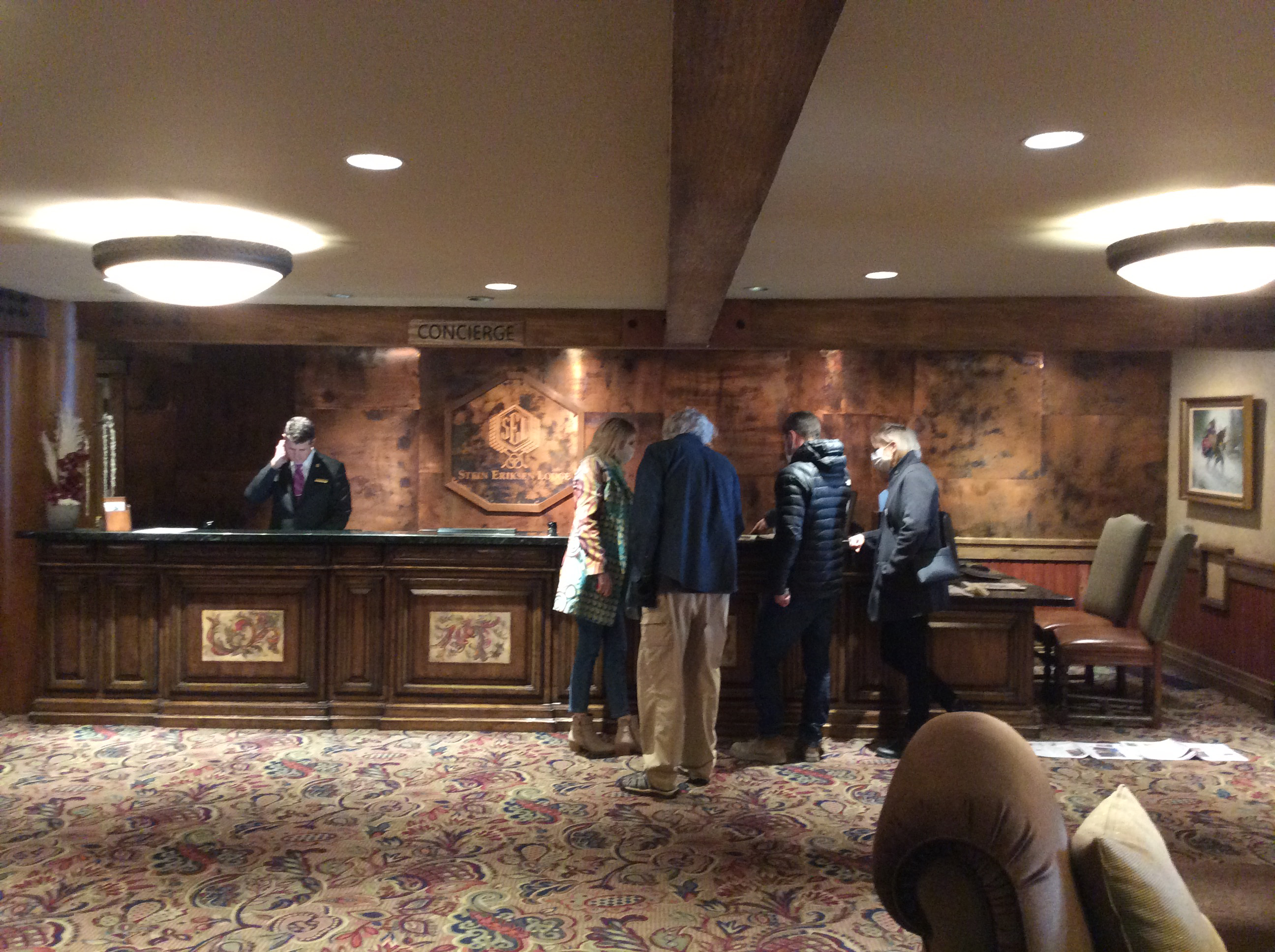 |
| In 2020 February, interior design team leaders for the project confer with Al preparatory to redesigning the concierge area. In addition to functioning as a creative consultant, Al's primary objective was to stand in the space for which the paintings were to be created so that all subsequent compositional and presentational aspects of the Studios' deliverables would be fully informed by the space. This involved envisioning not only the space as it was, but as it would become. |
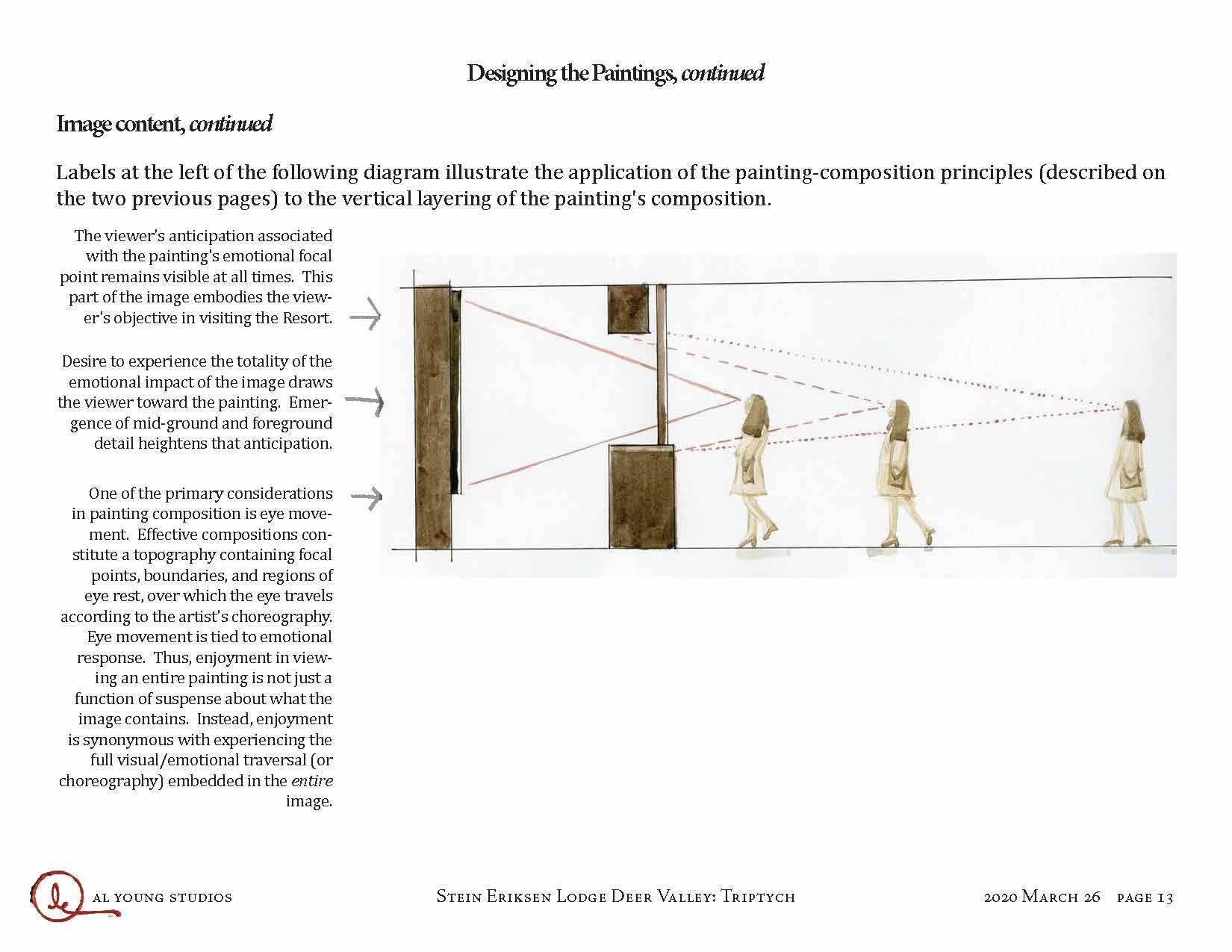 |
| Following the February site visit, the Studios prepared a design document setting forth principles influencing image composition and content. The purposes of this design document included: Confirming with the client the Studios' understanding of client objectives for the commissioned artwork. Secondly, customizing the paintings to the strengths and weaknesses of the space in which they would be displayed. Thirdly, shining a light into the realm of artwork creation so that client and team members might more fully understand both the artistic process and its result. |
Knowing that paint doesn't dry on any schedule but its own, the Studios worked closely with the design and construction team to build into the work as much elasticity as possible in terms of the paintings, and to preclude, to the greatest possible extent, any collisions among construction work and deliverables that might jeopardize not only the creation of the paintings, but might actually result in damage to them, particularly in the event that the artworks had to be installed before they had had sufficient time to dry.
These considerations were addressed by the team as a whole from the inception of the project, with the result that the work got done, installation was successful, and even changing deadlines were met. For example, the Studios was invited to participate in the on-site visit that launched the design project. That foresight on the part of this design team ensured that Studios' expertise concerning the myriad considerations involved in creating, delivering, and installing the commissioned artworks was present and active from the outset. For that foresight alone—something all too rare—the design team deserved a medal.
By the time the site visit occurred, the COVID pandemic was just beginning. The team would weather a full-scale societal shutdown and pandemic considerations all the way to project completion.
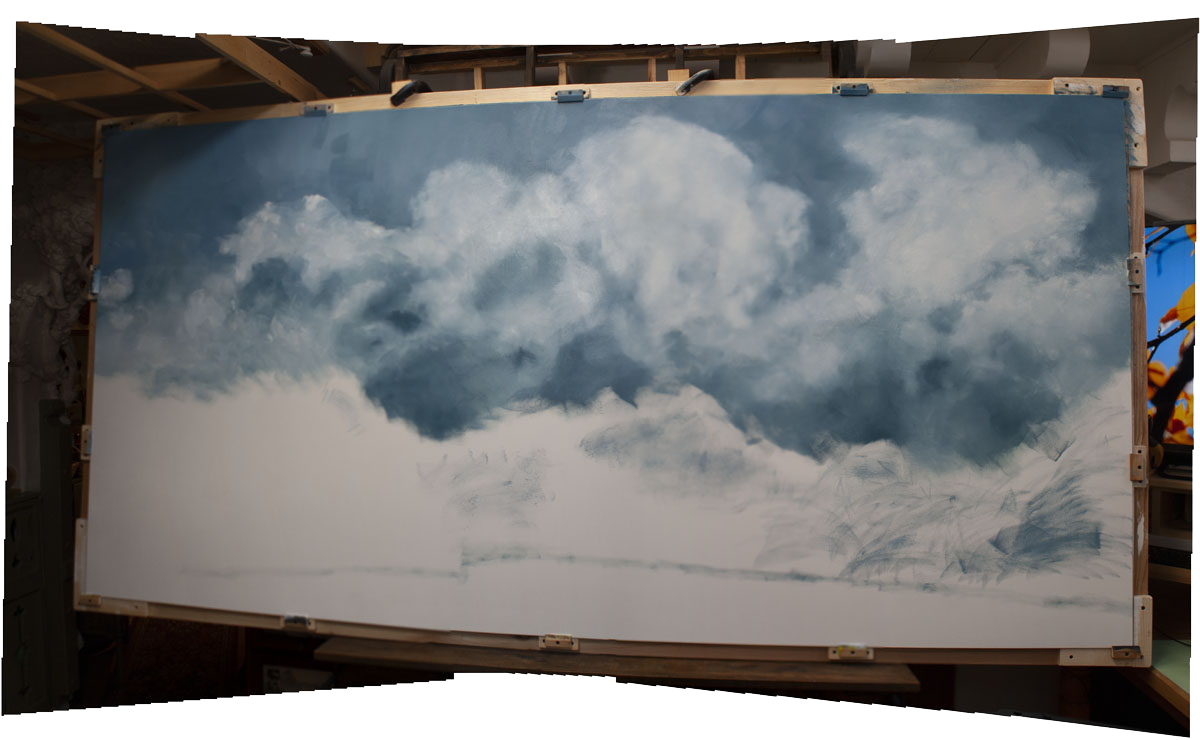 |
| This photograph shows the initial underpainting of the sky on the center panel of the triptych. This work was performed in the indoor studio, before the move outdoors was anticipated. The panels in these photographs are housed in studio crates to facilitate the handling of large sheets of Masonite (prone to bending), to protect panel edges and corners, and to transfer much of the work of a traditional easel to the panel. |
Health considerations (unrelated to the pandemic), surrounding our at-home studios, escalated to the point that it became necessary to move the entire project outdoors. This occurred midway of the brushwork.
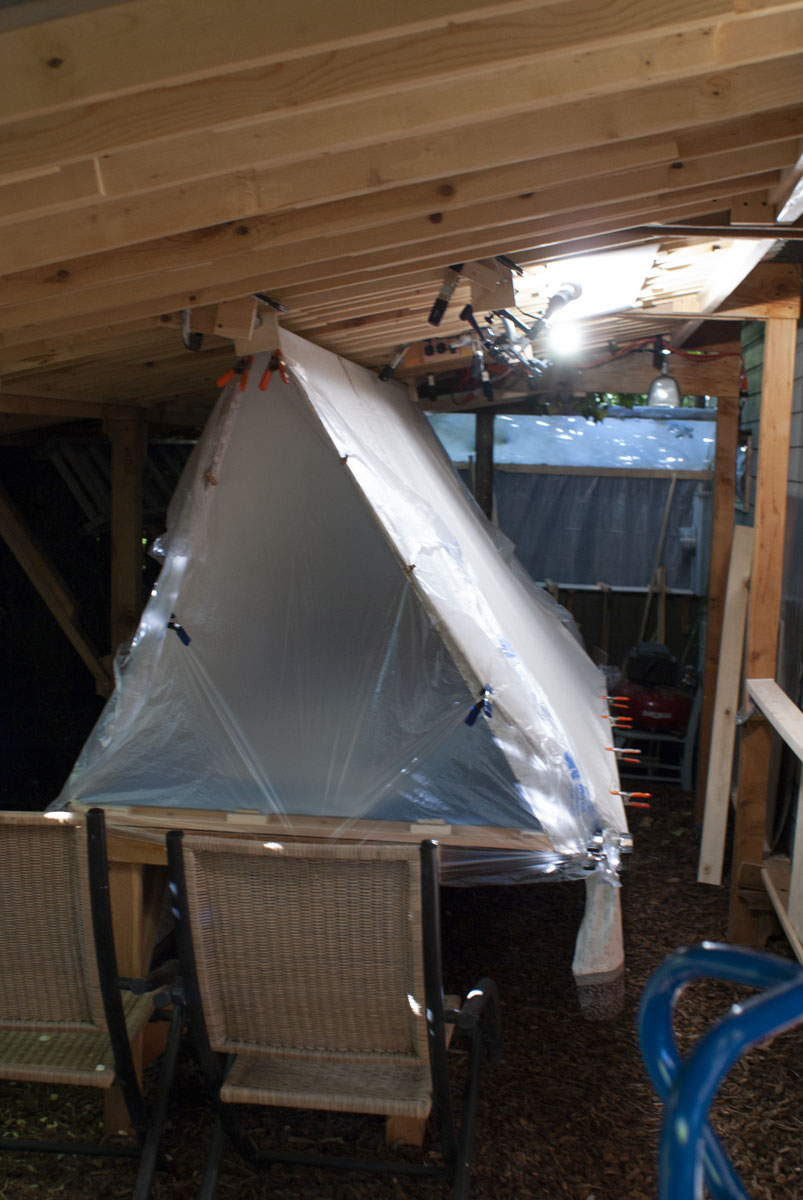 |
| With the expansion of the plein air studio ready for work, the first task was to coat the underpainting on the center panel with Gamblin's Solvent Free Medium gel. Once the application was completed, the painting was encased in the bug tent to dry. |
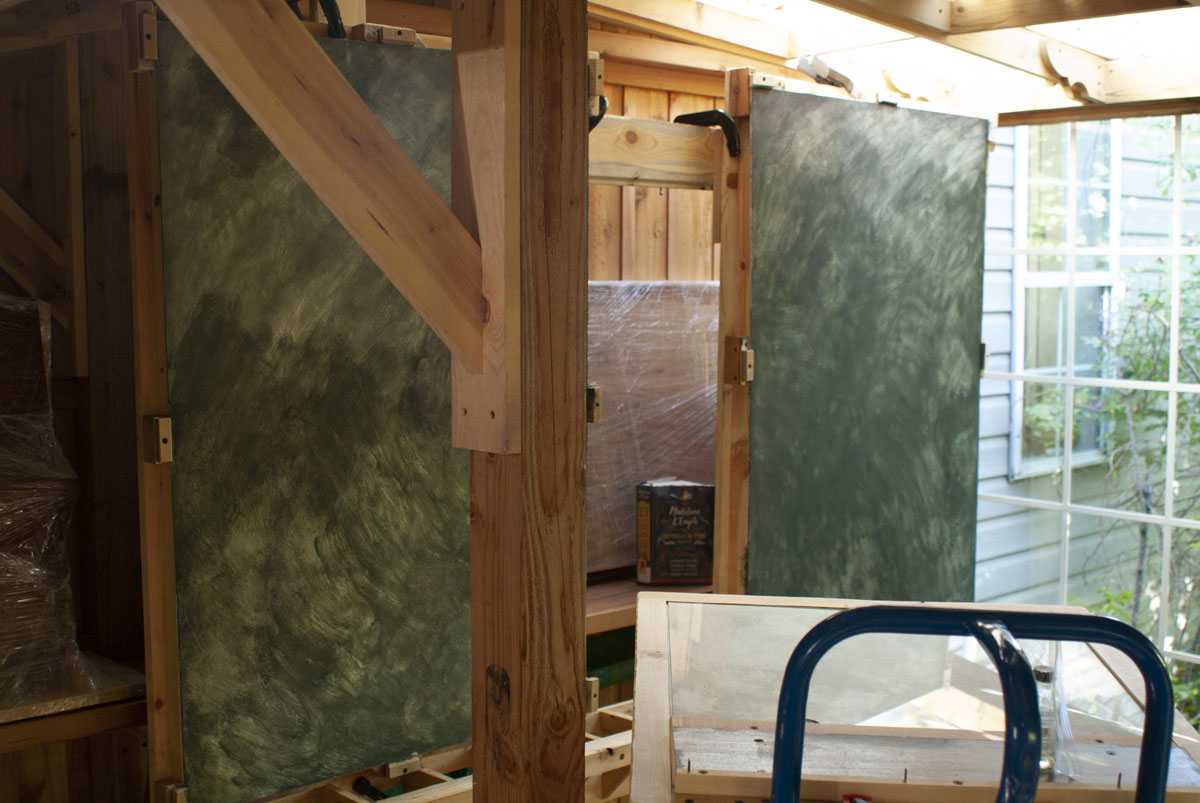 |
| The left and right panels of the triptych were clamped to the easel in the old plein air area. They appear here after the initial underpainting-sketch had been applied. The sketch was done with Chelsea Classical Studio Lavender Spike Oil Essence. This application dried quickly, precluding the need for bug-proofing the panels. |
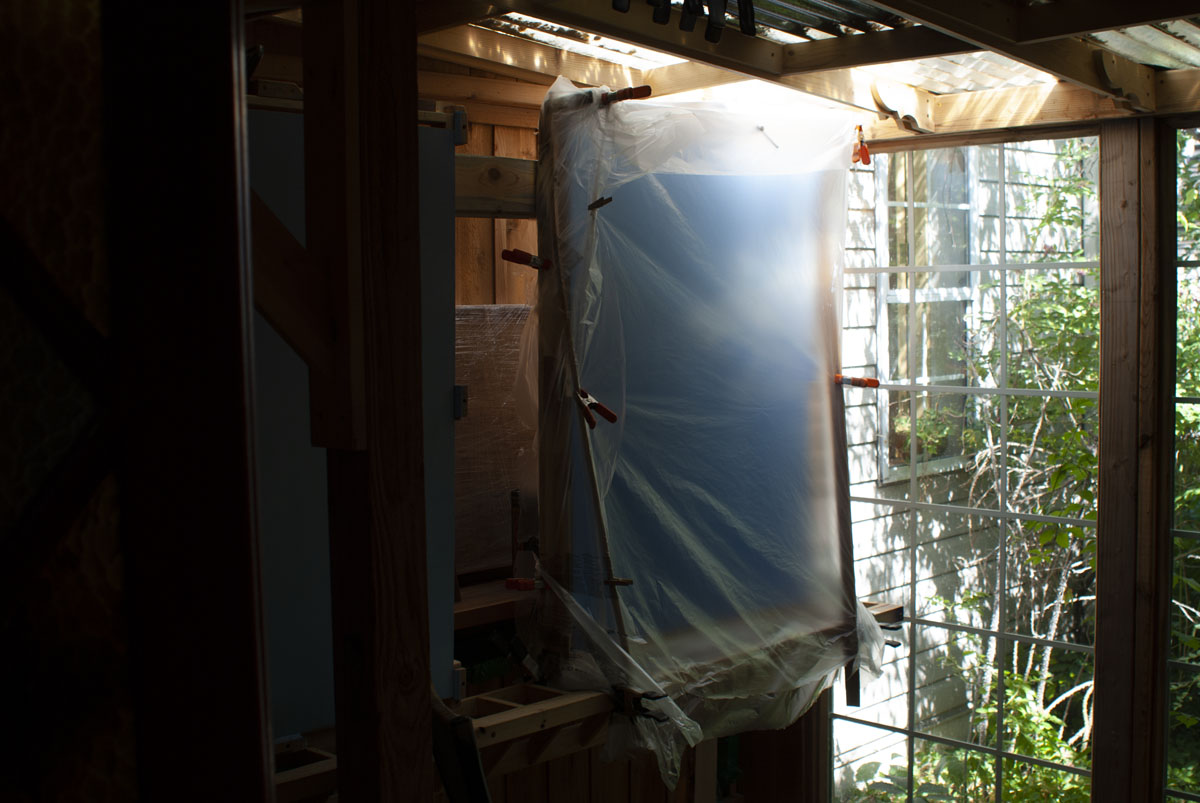 |
| Thin plastic sheeting was used to improvise a bug-free envelope in which one of the side panels could dry after having been covered with oils. |
As it turned out, I only rarely had all three panels in line, preferring to paint on them individually and, as often as possible, to put the wet panel up on one of the other easels in the plein-air area to dry out of harm's way. Of course, drying a painting outdoors presented its own wildlife problems. That's why the foregoing list of equipment created for this project includes a "bug tent" large enough to house the center painting. For the flanking paintings, I simply used plastic sheeting to enclose the panels individually, taking care to protect the wet surface of each panel from the plastic as well as bugs. And, since bugs weren't enough of a problem, itinerate neighborhood cats required the regular use of a bird net to keep cat paws and hair from becoming part of the paintings while panels rested on the draft-table-easel.
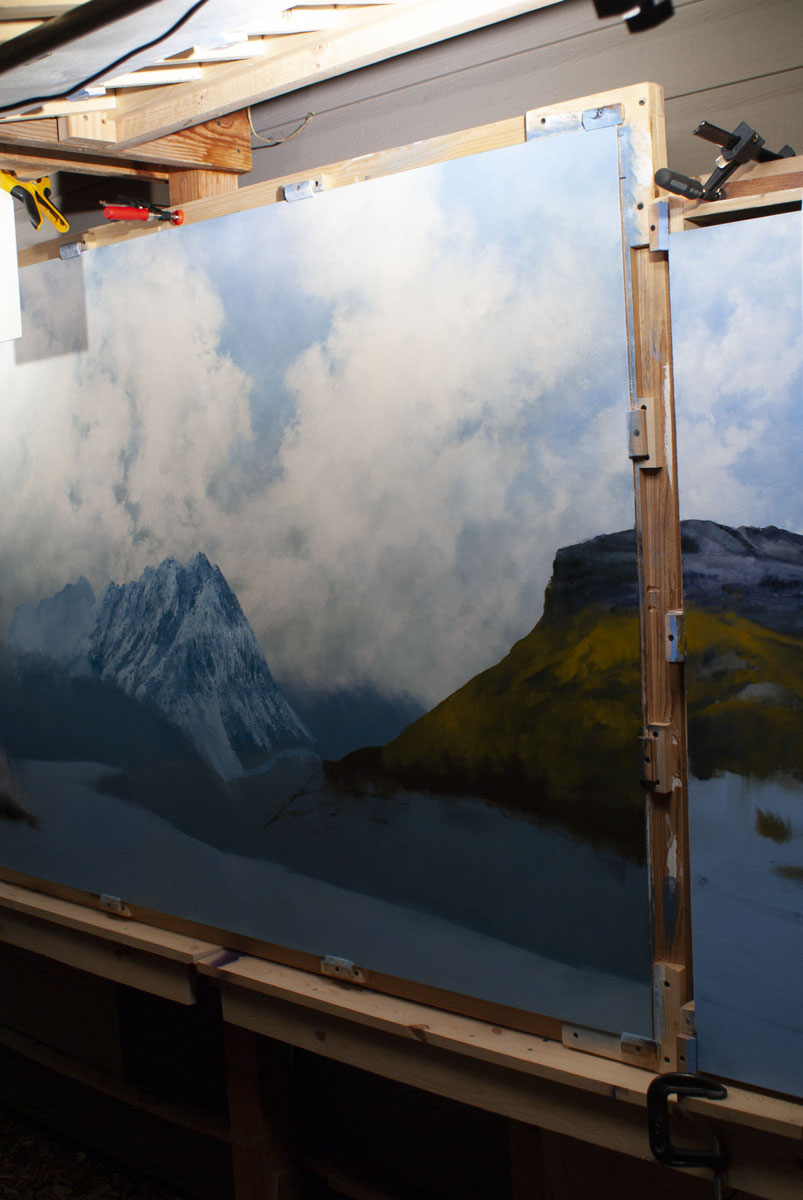 |
| The 4x4-post easel is used to complete the underpainting of the righthand panel and the right side of the center panel of the triptych. |
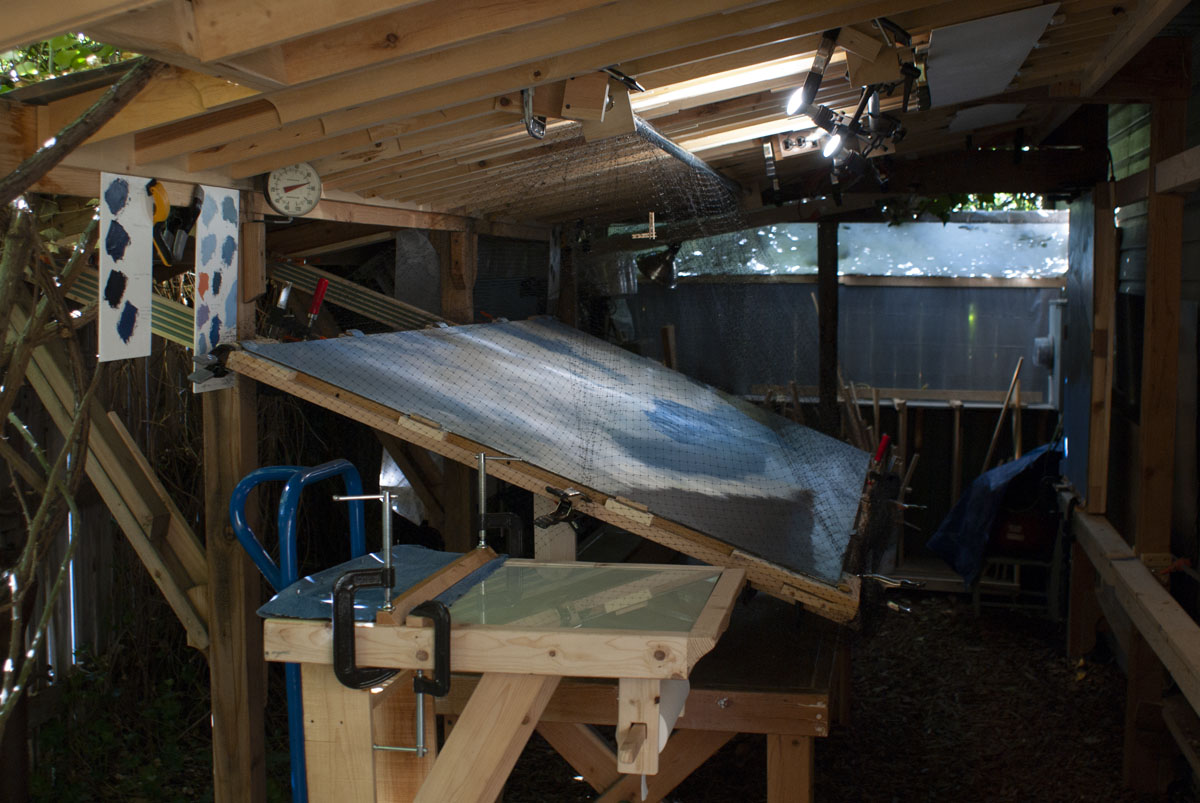 |
| Looking southward along the drafting-table easel, the center panel of the triptych is mounted across from the 4x4-post easel, along the wall. Floods mounted near the ceiling can be used to illuminate either easel. The pipe (top center in photograph above), mounted under the ceiling and running the length of the drafting table easel, serves as the ridgepole for the bug tent. In this photo, however, a garden net (typically used to keep birds from eating fruit and other produce) has been draped over the pipe to serve as a cat net. Roaming neighborhood cats frequenting the garden surrounding the plein air studio are prevented from marring the surface of the painting when the studio is not in use. The top of the dolly-turned-palette, with its paper-towel rack, stands in the foreground. |
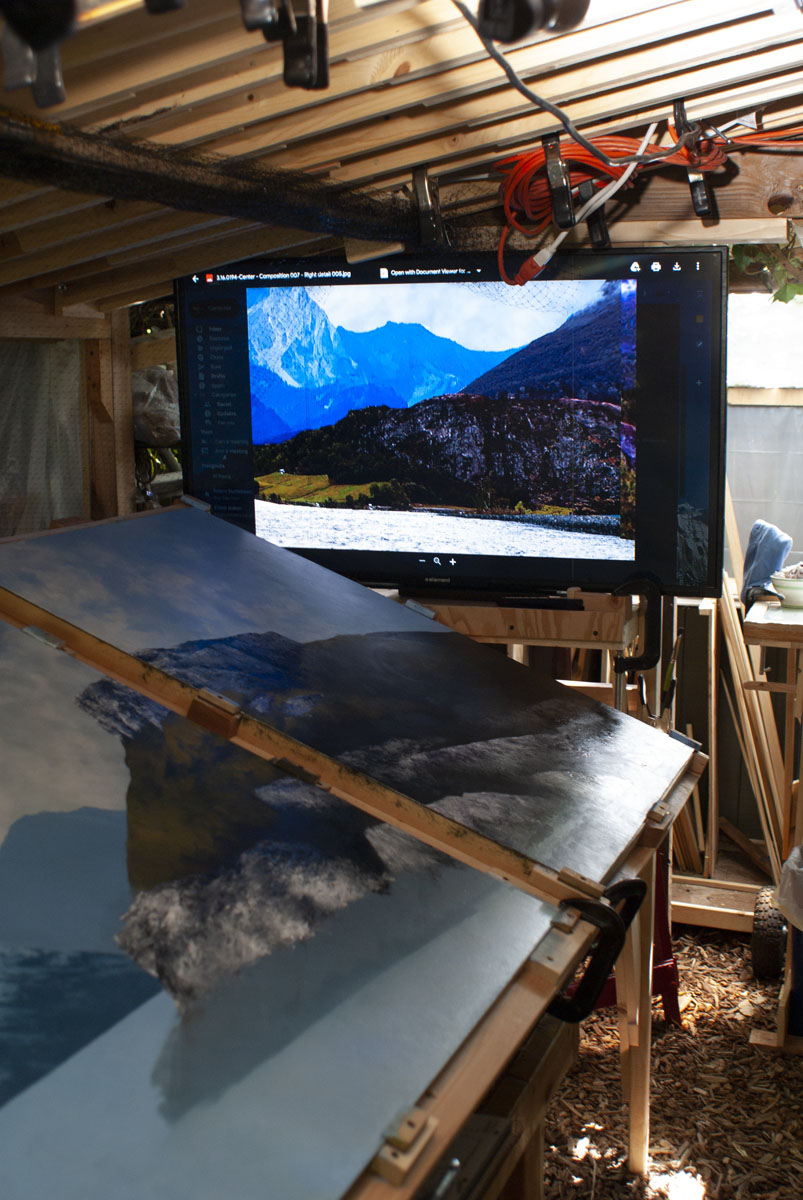 |
| A large, flat-screen is mounted at the end of the drafting-table easel so that digital images can be displayed for reference. In the foreground, the righthand panel of the triptych and the right side of the center panel are side-by-side for convenience in painting the two panels as one. |
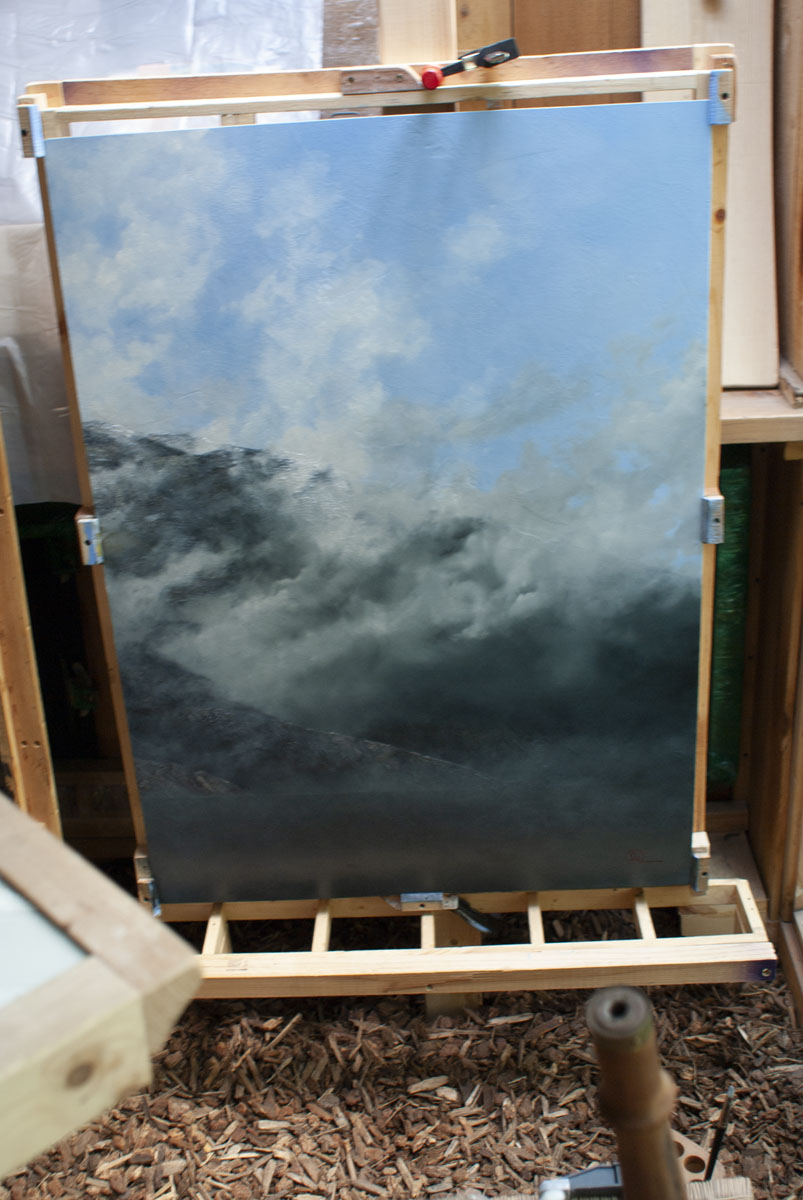 |
| The signed, righthand panel of the triptych dries in the old plein air studio. |
With workspace and equipment once again ready for work, I had to deal with completing the paintings in the longest stretch of record-breaking summer heat in the region's recorded history. That was accomplished simply by working during the coolest hours of the day; even so, I learned to be wary of the signs of heat stroke. Like the bug tallies, I didn't take time to record everything, but looking back over the period from July 25 – August 25, the average daytime high was just over 95F.
The move outdoors also coincided with the most active wildfire season on record, not only locally, but in regions feeding our prevailing winds so that wildfire smoke, as it always does, piles up against the western slopes of the Wasatch Range even if the fires are burning on the west coast of North America.
Finally, in the closing weeks of the project, the deadline for delivery of the paintings was moved up.
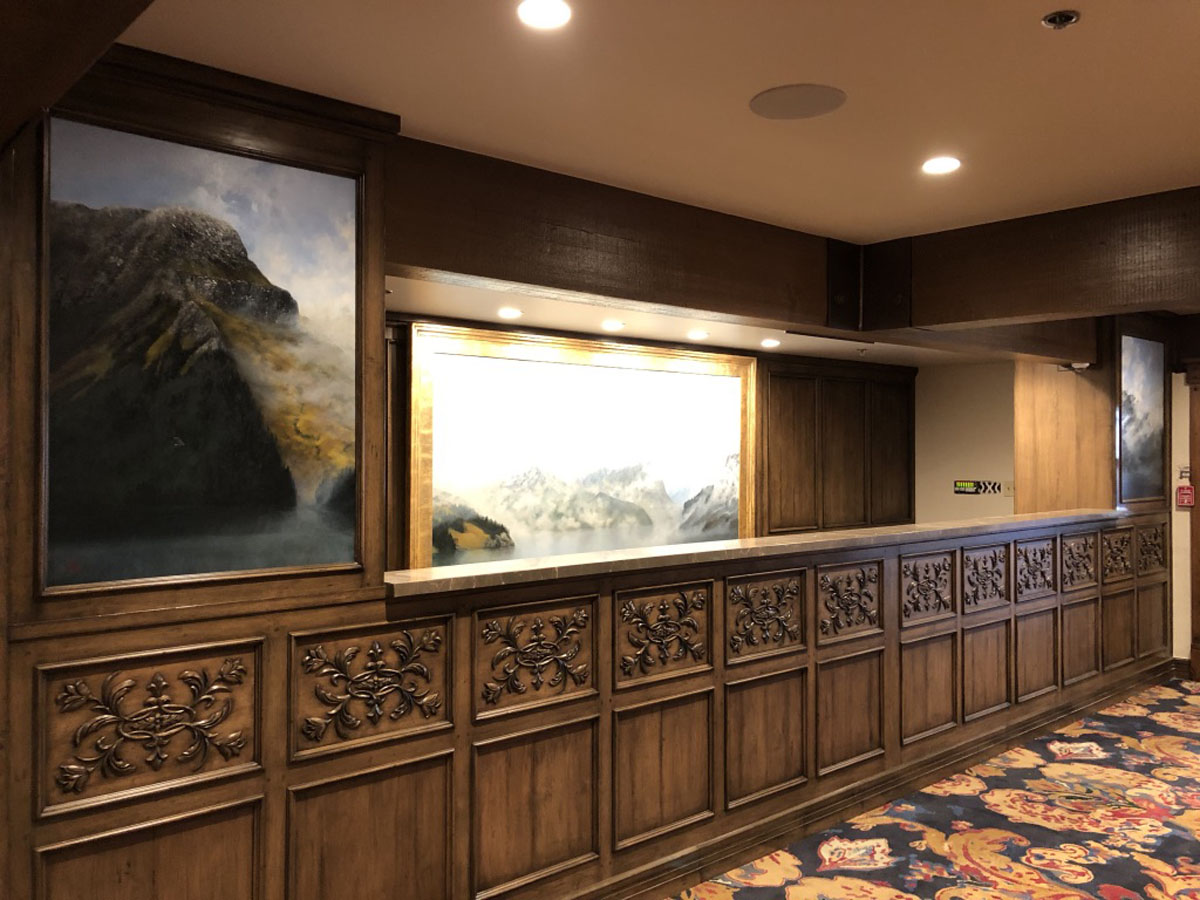 |
| The lefthand panel of the triptych is mounted into the raised paneling to the left of the concierge desk. The center panel of the triptych is mounted to the wall behind the concierge desk. |
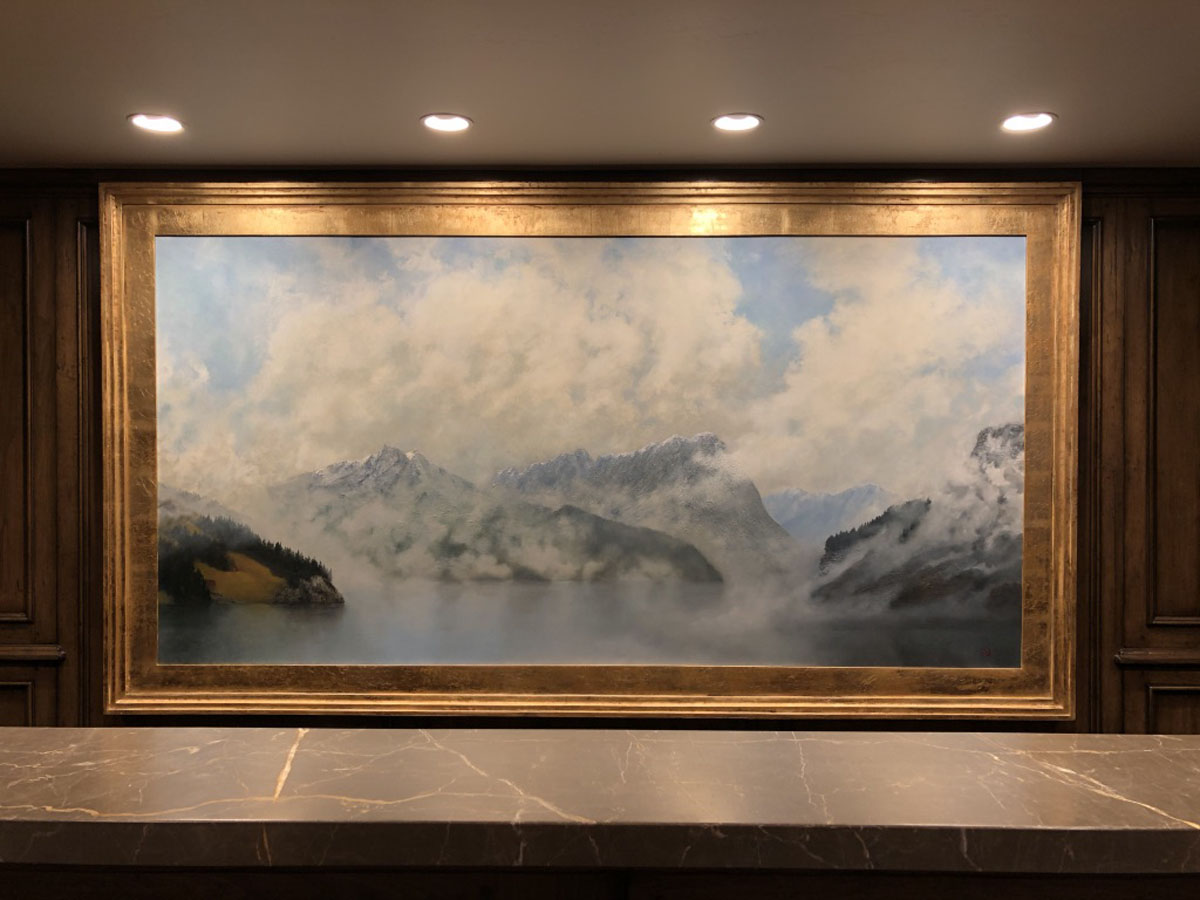 |
| The center panel of the triptych is mounted in a custom frame designed and created by Al and Ashton. |
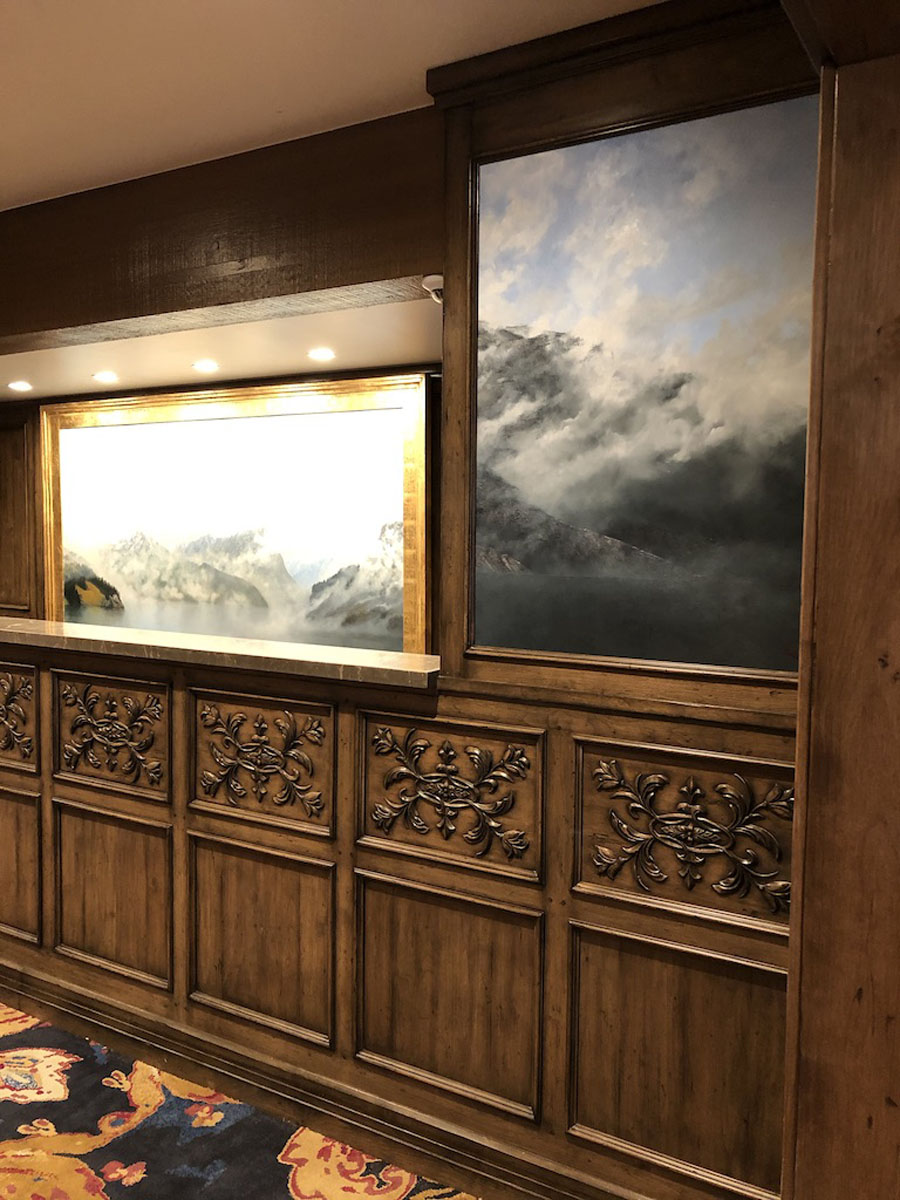 |
| The righthand panel of the triptych is in the foreground. The triptych's center panel is mounted to the wall behind the concierge desk. |
Tags: 3.00.00304.010, 2020, Project commentaries
Browse articles by year: 2025 . 2024 . 2023 . 2022 . 2021 . 2020 . 2019 . 2018 . 2017 . 2016 . 2015 . 2014 . 2013 . 2012 . 2011 . 2010 . 2009 . 2008 . 2007 . 2006 . 2005 . 2004 . 2003 . 2002 . 2001 . 2000 . 1999 . 1998 . 1997 . 1996
Browse articles by topic: Art lessons . BenHaven Archives . Blank art diaries . Fine art photography . Framing . Illustration . Inspiration and creativity . Isles of Rune . Limited Editions Collection . My Fathers Captivity . News . Novellas . Oil paintings and prints . Operations announcements . Orders and shipping . Overview . Portfolios . The Papers of Seymore Wainscott . Project commentaries . Recipes by Nancy Young . Recommended reading . Recommended viewing . Temple artworks . The Storybook Home Journal . Tips and techniques . Tools supplies and operations
Browse articles by topic: Art lessons . BenHaven Archives . Blank art diaries . Fine art photography . Framing . Illustration . Inspiration and creativity . Isles of Rune . Limited Editions Collection . My Fathers Captivity . News . Novellas . Oil paintings and prints . Operations announcements . Orders and shipping . Overview . Portfolios . The Papers of Seymore Wainscott . Project commentaries . Recipes by Nancy Young . Recommended reading . Recommended viewing . Temple artworks . The Storybook Home Journal . Tips and techniques . Tools supplies and operations